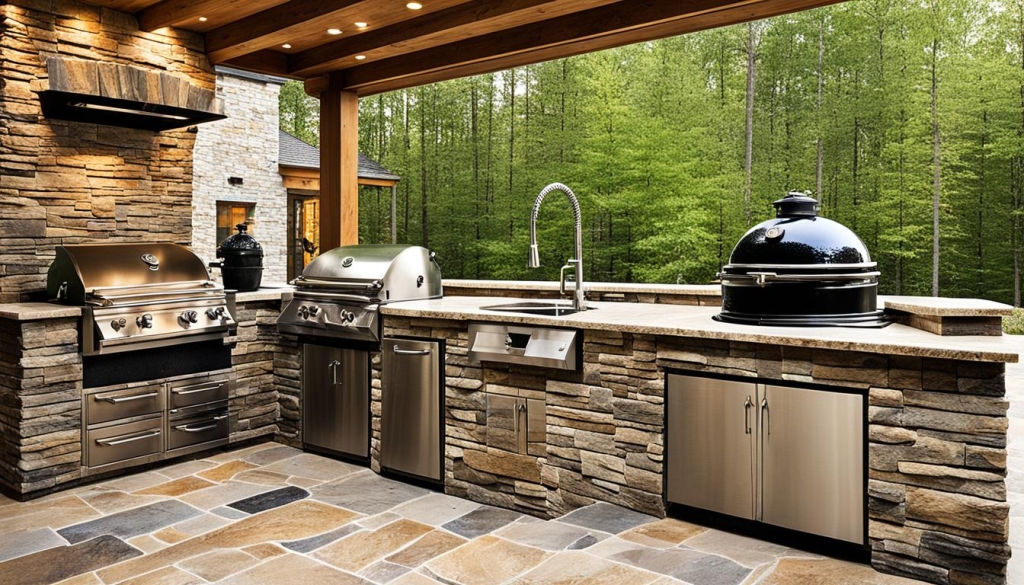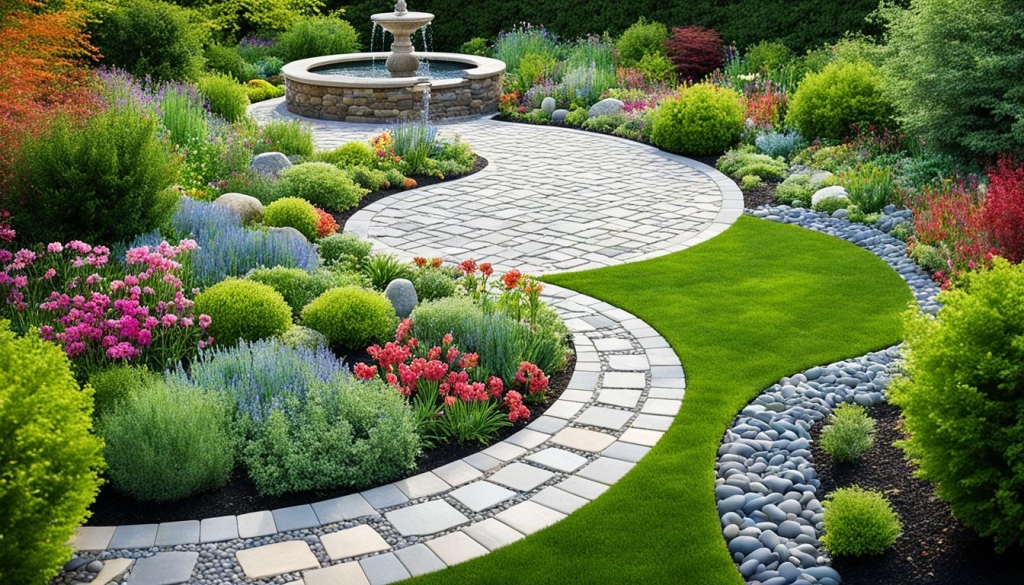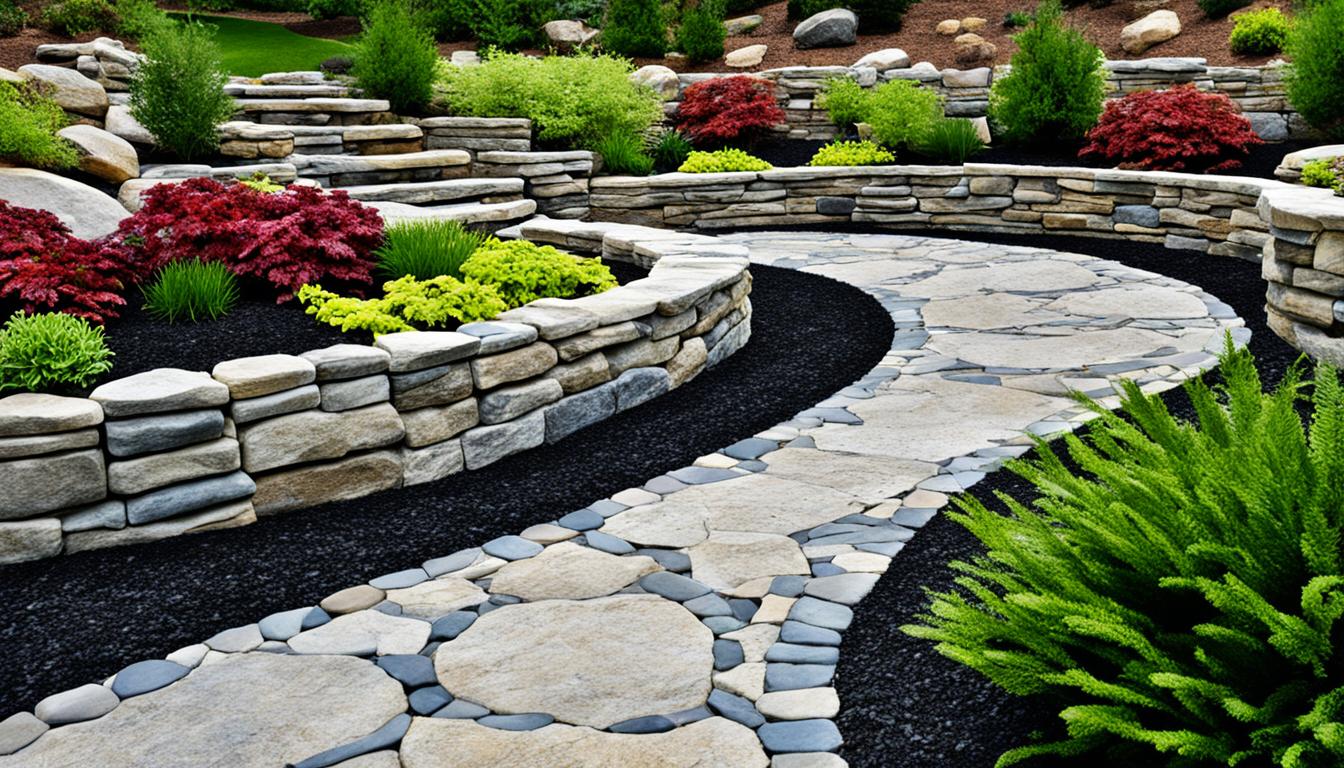Table of Contents
Understanding the Benefits of Natural Stone in Outdoor Spaces
Backyards are key for fun and rest; natural stone makes them look better. Each stone slab is unique and brings beauty and worth to your home. Choosing the best natural stone for outdoor applications depends on your needs and how you want it to look. Granite, limestone, and sandstone are top picks because they last long, look good, and are tough.
Key Takeaways
- Granite, limestone, and sandstone are chosen often for outdoor uses.
- Granite stands up well to weather changes, making it great for all seasons.
- Limestone has a classic beauty and is good for areas with less foot traffic or peaceful garden walks.
- Sandstone has lively colors and smooth surfaces, fitting for moderate weather.
- Think about your local weather and space type when picking the best stone.
- Granite or quartzite are better choices for places with frequent weather changes. Sandstone, bluestone, and flagstone are better choices for gentler climates.
Natural stone adds beauty to your outdoor areas. It also lasts long and connects us to the earth through its unique looks. You can raise your property’s value by choosing the right types of stone for outdoor use. And you’ll get a classy look that lasts for years.
Durability and Resilience
Granite is known for its ability to resist weather. It’s a top outdoor stone option in harsh climates. Granite can handle extreme cold or heat and lots of use. It’s perfect for patios, paths, and pool sides. Limestone, with its subtle beauty, is great for peaceful places.
| Stone Type | Durability | Ideal Use |
|---|---|---|
| Granite | High | Severe climates, high-traffic areas |
| Limestone | Medium | Tranquil, low-traffic areas |
| Sandstone | Medium | Moderate climates |
Aesthetic Appeal
Marble is famous for its classic look and detailed veins. It adds sophistication to any design. Granite offers a striking option with its speckled look. This makes it another top outdoor stone option.
The finish of the stone is key for outdoor use. Polished marble is beautiful but can erode and be slippery. So, rough finishes like tumbled or leathered are better outdoors. The same goes for granite, which is more slip-resistant with honed or leathered finishes. This maintains its durability.
When choosing tiles, think about size. Larger tiles make a space look bigger. Smaller tiles allow for detailed designs, like mosaics. This enhances your outdoor design overall.

Choosing the Right Natural Stone for Your Outdoor Project
Picking the right stone for outdoor areas is about looks and practicality. You need to think about the weather and how you’ll use the space. It’s vital to pick materials that withstand the elements or blend with your garden’s vibe.
Climate Considerations
The climate is key in selecting the perfect stone for outdoors. Granite and quartzite work well in places with big temperature changes. They are tough and resist weather damage. In milder areas, sandstone, bluestone, and flagstone look great and are practical, enhancing the natural look with their colors and textures.
Space and Functionality
It’s crucial to consider what the space will do when choosing stone. Different stones change a space’s atmosphere. Limestone is great for quiet spots with less walking, like calm garden paths. But, sandstone is versatile and colorful, ideal for different uses in moderate climates.
Also, think about stone size and layout. Smaller stones make for cozy paths and nooks. Bigger slabs fit well in large patios and gathering spots. Your stone choice affects the area’s mood, making spaces welcoming for both practical and beautiful reasons.
Below is a comparative table of popular stone materials for outdoor projects:
| Stone Type | Durability | Climate Suitability | Aesthetic Characteristics |
|---|---|---|---|
| Granite | High | Extreme Weather | Resistant to weathering, durable |
| Limestone | Medium | Mild | Soft palette, timeless elegance |
| Sandstone | Medium | Moderate | Vibrant palette, sleek surfaces |
By considering these points, you can choose the best natural stone for your project. You’ll find the perfect balance between function and beauty.
Top Outdoor Stone Options for Different Applications
Selecting the ideal natural stone for outdoors is more than about looks. It means knowing each stone’s unique features and advantages. We’re looking at two top picks for outdoor uses: granite and sandstone. Their particular qualities suit different environments and help bring your outdoor ideas to life.

Granite
Granite is known for its outstanding durability and beautiful look. It’s among the top 10 most mined minerals in the USA. Its high demand shows its quality and flexible use. Ideal for uses like natural stone patios, fire pits, and around pools, granite withstands weather changes well.
A granite patio lasts long and can boost your home’s value. With its polished look and natural beauty, it’s a top choice for outdoor stone projects.
Sandstone
Sandstone, with its natural tones, is great for peaceful outdoor areas. Best for mild climates, it’s more porous and softer than granite. This means it may wear faster under lots of use or in harsh weather. Yet, with the right care like sealing and maintenance, its beauty lasts longer.
Though a bit delicate, sandstone is versatile. It can be shaped into various designs, ideal for gardens, patios, and paths. It matches the natural surroundings and adds a welcoming feel.
Choosing granite or sandstone depends on your area’s climate and your taste. Each offers unique benefits, ensuring your outdoor area is both lovely and durable.
Outdoor Stone Installation Tips
Starting an outdoor stone project can make your outdoor area look stunning and elegant. But it’s key to stick to some important outdoor stone installation tips to make your project last.
Hiring Professionals
Hiring experienced professionals is crucial. Working with expert stone installers ensures top-notch results. They know how to work with materials such as the stone veneer from Casa di Sassi. This veneer offers a 50-year warranty against major issues, but only if installation meets specific standards.
Getting a skilled installer means they’ll use the right mortar, making the stones stable and secure. They also suggest ways to improve your project, like adding special stones or features. For more advice, check out this helpful blog.
Sealing and Maintenance
Sealing and upkeep are key for any stone project. Properly sealing your stonework protects it from the weather, keeping it looking great. Teaching homeowners about sealing helps them keep up with maintenance.
Casa di Sassi has various stone veneers, each needing different care. Sealing them, especially in damp areas, helps them last longer and look better. Also, using the right mortar technique when installing the stones can reduce future upkeep.
Choosing the right grout color and thickness is important for the look of your stonework. The wrong grout can ruin the appearance of your stone project.
| Installation Step | Tips and Standards |
|---|---|
| Hiring Professionals | Ensure professionals follow NCMA standards and use premixed Type S mortar for stability. |
| Sealing and Maintenance | Regular sealing in high-moisture areas and correct grout selection are essential for longevity. |
| Enhanced Aesthetics | Install stone accessories like wall caps and mantels to improve the overall look. |
Best Natural Stone for Outdoor Applications
When picking natural stone for the outdoors, consider its endurance, look, and climate fit. Granite and limestone stand out for outdoor areas. Each has its own benefits depending on the setting.
Granite
Granite is a top pick for outdoor stone because of its toughness. It handles harsh weather well. This makes it perfect for places with big temperature changes.
It’s also scratch-resistant and easy to take care of. Granite’s varied colors and patterns add beauty to any outdoor area.
Limestone
Limestone is loved for its gentle colors and smooth look. It works best in places that don’t get too much foot traffic. This stone is durable and simple to keep up with.
It keeps its color well, even outdoors. Limestone is great for making a calming space in gardens or patios.
To keep granite and limestone looking good, it’s important to seal them. Sealing helps them last longer and makes upkeep easier.
Outdoor Stone Maintenance Guide
Maintaining outdoor stone installations needs consistent effort. Regular cleaning and occasional sealing help keep them beautiful and durable. The care needed may change with different types of stone.
Regular Cleaning
Cleaning your stone surfaces often prevents damage. It’s good to clean outdoor stone areas at least three times a week. This stops stains, sand, and dirt from harming the stone. A non-treated dry dust mop works best for this job.
Use coasters under drinks to avoid etching. Choose neutral cleaners made for stone. Stay away from acid or bleach-based products to prevent damage.
Periodic Sealing
Sealing your stone helps it resist stains but doesn’t make it stain-proof. Newly installed stones like marble, granite, and limestone benefit most from sealing. There are two main types of sealers:
- Penetrating/Impregnating Sealers: These go into the stone’s surface, making it water-resistant.
- Stone Enhancer Sealers: These sealers also improve the stone’s color for a richer look.
Professional help is needed for etch marks from acids, like lemon juice, to save the stone’s finish. Also, don’t remove efflorescence, the white powder on stones, with water. For tough maintenance problems, always ask a stone expert. They should also check and fix any damage regularly.
This guide helps keep your outdoor stone looking good. You protect your investment and keep your stone features looking great.
Conclusion
Using natural stone outside is a smart choice. It looks good and lasts a long time. When you pick the right stone for places like your outdoor kitchen or patio, you make your home more beautiful and welcoming. Granite, quartzite, and porcelain are great choices for these areas. Each has its own benefits.
Granite is very adaptable. It can be shaped and colored in many ways, making it both pretty and strong. It’s perfect for busy places or your outdoor kitchen counters. Quartzite is also great because it’s very hard and doesn’t slip, making it safe and durable. Lastly, porcelain is a top pick for patios. It can handle all kinds of weather well.
Knowing what your outdoor space needs helps you pick the best stone. You might choose granite for its toughness, quartzite for its strength, or porcelain for its versatility. The right stone can increase your home’s value and make your outdoor area lovely and strong. Keep these areas clean and sealed, and they’ll last a long time. This way, your outdoor space stays beautiful year after year.
FAQ
What is the best natural stone for outdoor applications?
Granite is the top choice for outdoor use. It’s very strong and looks great. It stands up well to all kinds of weather, making it perfect for any climate.
What are the top outdoor stone options?
The best outdoor stones are granite, limestone, and sandstone. Granite lasts a long time. Limestone is beautiful in a quiet way. Sandstone comes in many colors and is very flexible.
What are some outdoor stone landscape ideas?
Try using big pieces of granite for your patio. Use sandstone for walkways in your garden. Limestone is great for peaceful sitting spots. These stones look good together and make your outside space beautiful.
Which natural stone patio materials are recommended?
Granite and sandstone are best for patios. Granite is tough and can handle lots of walking and weather. Sandstone has a warm look that makes outdoor areas inviting.
What types of stone are suitable for outdoor use?
Granite and quartzite are good for changing temperatures. Sandstone and bluestone are best in steady climates. Flagstone is chosen for its unique look and feel.
What is the best stone for outdoor kitchens?
Granite is the top pick for outdoor kitchens. It’s strong and can take the heat. It stays looking good, even with heavy use.
What are some outdoor stone installation tips?
It’s smart to have a pro do the installation. Make sure the stone is sealed to guard against weather. Pick finishes that prevent slipping in wet spots for safety.
How do you maintain natural stone outdoors?
Keep it clean and seal it when needed. Clean it with a stone cleaner that’s pH-neutral. Re-sealing helps keep out stains and weather damage.

